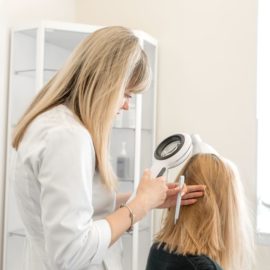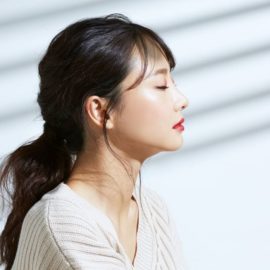The well-aging movement has taken all cosmetic and personal care sectors by storm, and hair care is no exception. In such a context, companies have embarked on a quest to find the hair growth ingredient that encompasses new feelings around scalp aging and the self-care that consumers are demanding.
At Provital, our continuous R&D efforts have reached a new milestone for taking care of how hair and scalp evolve as time passes. This has meant we’ve developed a revolutionizing hair growth ingredient that also takes care of hair graying concerns and hair wellness in general. Keep reading to find out about aging signs in hair and how to meet consumers demands today.
Content
Well-aging in the hair care segment and the search for a new hair growth ingredient
As the hair care industry bounces back from a short pandemic halt and is now expected to grow at a CAGR of 4% until 2026), a new type of consumer is in fact expecting increasingly sophisticated products that cater to their specific needs.
In this context, hair loss issues continue being the top concern for consumers in the hair care sector. In fact, a Lighspeed/Mintel Hair survey found out a majority (33%) of respondents said fighting hair loss was their most desired benefit in haircare.
The quest for the ultimate hair growth ingredient is in fact immersed in the wider search for understanding the visible signs of aging in hair and the scalp: as hair follicles miniaturize, hair gets thinner, loses volume and breaks easier, while growth takes longer to happen. A successful hair growth ingredient will thus target hair issues from their root: hair follicles.
However, the biggest transformation companies are addressing now is how this quest for a hair growth ingredient that engages with the current well-aging movement, which aims at accepting rather than “correcting” aging signs.
Plus, in the era where image means all, a segment of consumers are choosing to regard their wellbeing from a holistic point of view and understand self-care and self-esteem are intrinsically related to hair health. In fact, the psychotrichology field of study is already addressing the psychosomatic factors in hair health such as hair loss and premature hair graying.
As the scientific community and society at large continue understanding more about how emotions and mental states such as stress, depression or anxiety affect scalp health, the new successful hair growth ingredient will be part of the “well-aging” movement or it will not be. In this context, formulas such as scalp stimulators for hair growth are clear winners.
It’s time to enter a new age where imagocracy (today’s zeitgeist obsession with one’s self-image) turns into psychoaesthetics, where consumers are looking to feel well and then match how they feel to how they look, building their self-esteem and self-confidence from there.
Understanding how the hair loss process works to choose the best hair growth ingredient
Current scientific research has provided an unprecedented clear view of the diverse causes that can lead to hair loss. This, as we’ll see below, has created unparalleled opportunities for creating the most successful hair growth ingredient yet.
The scientific consensus around hair loss explains how hair thinning and loss originate in a process called follicle miniaturization. This involves once healthy hair follicles not being able to generate healthy hair and in fact presenting weaker hair strands and scalp-related issues. Taking this into account, successful hair growth ingredients have focused on helping restore the hair growth cycle to its original, healthy state.
So innovative research has been focusing on hair loss from different sides. On the one hand, and as we’ve mentioned above, there’s a growing scientific consensus on how psychological disorders and hair diseases are linked, including studies on how stress hormones impair stem cells necessary for hair growth (Ya-Chieh Hsu, 2021). While on the other hand there is the research on hair follicle aging, where scientists have proven how the growth cycle is affected by a lack of collagen XVII (Matsumura et al. 2016), consequently suggesting how the next successful hair growth ingredient should tackle COL17A1 deficiencies.
Kerascalp™: the hair growth ingredient that hampers follicle aging
At Provital, our search for a hair growth ingredient that targets hair follicle aging and miniaturization has a new champion. Kerascalp™ is a natural active ingredient that prevents follicle miniaturization by increasing Collagen XVII protein and reducing its proteolysis .
Derived from the well-known Ayurvedic ingredient Amla (Phyllanthus emblica) fruits, this active ingredient is in fact able to halt other visible signs of aging, including hair graying, thanks to its proven action in maintaining melanocyte stem cells, related to this process.
This represents a ground-breaking discovery, as Provital becomes the first company to describe the dual effect of Amla on both hair follicle miniaturization and pigmentation.
Additionally, its results have been tested in a panel of people that included men and women and people suffering from stress, thus having the potential to become the ultimate hair growth ingredient that shows efficacy in a wide range of profiles.
It all comes down to this ingredient’s capacities to activate and limit degradation in Collagen XVII. Plus, our In vivo studies have shown Kerascalp™ to be able to clinically improve or maintain hair growth in the following ways:
- 49% increase in the number of total hair
- 56% increase in the number of of thick hairs
- 31% increase in hair resistance/hair strength
- 12% increase of hair follicles in anagen stage (the stage at which follicles produce new hair).
- +8% hair darkening
- +31% healthy hair appearance
- -55% Gray hair
All in all, Kerascalp™ is able to respond to new haircare market concerns by its action on hair age, follicle miniaturization and follicle pigmentation at the same time, thanks to its positive impact on Collagen XVII.
Based on a natural ingredient backed by the centuries-old medicinal tradition of Ayurveda, this ingredient also adds to the well-aging discourse by helping brands develop narratives around natural ingredients and wellbeing.
No comments yet
There are no comments on this post yet.





Leave a comment